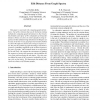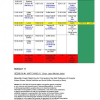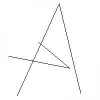ISCI
2007
14 years 4 months ago
2007
Graph matching and graph edit distance have become important tools in structural pattern recognition. The graph edit distance concept allows us to measure the structural similarit...
PAMI
2006
14 years 4 months ago
2006
A binary linear programming formulation of the graph edit distance for unweighted, undirected graphs with vertex attributes is derived and applied to a graph recognition problem. ...
FPGA
2008
ACM
14 years 6 months ago
2008
ACM
Pattern-based synthesis has drawn wide interest from researchers who tried to utilize the regularity in applications for design optimizations. In this paper we present a general p...
ICCV
2003
IEEE
14 years 10 months ago
2003
IEEE
This paper is concerned with computing graph edit distance. One of the criticisms that can be leveled at existing methods for computing graph edit distance is that it lacks the fo...
GBRPR
2007
Springer
14 years 10 months ago
2007
Springer
In the field of structural pattern recognition graphs constitute a very common and powerful way of representing patterns. In contrast to string representations, graphs allow us to ...
ICPR
2004
IEEE
15 years 5 months ago
2004
IEEE
Graph edit distance provides an error-tolerant way to measure distances between attributed graphs. The effectiveness of edit distance based graph classification algorithms relies ...
ICPR
2006
IEEE
15 years 5 months ago
2006
IEEE
General graph matching methods often suffer from the lack of mathematical structure in the space of graphs. Using kernel functions to evaluate structural graph similarity allows u...
ICIP
2007
IEEE
15 years 6 months ago
2007
IEEE
This paper introduces an invoice analysis approach using CaseBased Reasoning (CBR). CBR is used to analyze and interpret new invoices thanks to the previous processing experiences...




